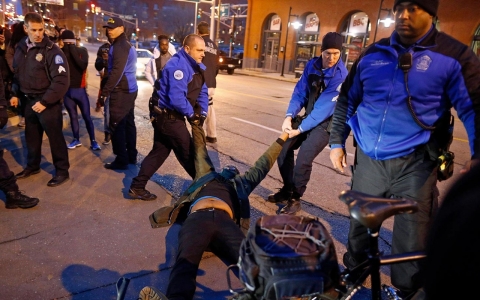More than 200 people were arrested overnight Thursday in New York as protesters swarmed the city’s streets and other cities across the United States for a second day to denounce a grand jury’s decision not to indict a white police officer in the chokehold death of an unarmed black man.
The wave of protest began on Wednesday after no charges were brought against Officer Daniel Pantaleo for his role in a confrontation on July 17 that killed Eric Garner and was captured on video by a bystander.
The reaction echoes the outrage after a grand jury also declined to indict a white policeman for killing an unarmed black teenager in Ferguson, Missouri, and is part of a larger effort to highlight what some believe is an ongoing national problem of police brutality.
U.S. Attorney General Eric Holder has mounted a civil rights review of the Missouri shooting and promised a full investigation of the New York case.
The second round of protests in New York City began Thursday evening during rush hour, with participants weaving between cars and trucks and bringing traffic on some streets to a near standstill. The marches picked up recruits along the way, shifted directions, splintered and regrouped and remained relatively peaceful.
Tensions rose as at least 3,000 protesters converged in Times Square about an hour before midnight. Blocking the major interaction of 42nd Street and Seventh Avenue, they chanted at police, "Who do you protect?" Soon hundreds of officers shoved them onto sidewalks.
Earlier, protesters in lower Manhattan staged sporadic sit-ins at intersections before police in riot gear warned them to move on or face arrest. Most complied.
Sharon Gordon, 52, of Matawan, New Jersey, said she hoped politicians would take heed. “There’s been a confluence of social media and outrage,” she said. “I do believe, for the first time, we’re about to make a change.”
Waves of marchers also blocked traffic on two bridges between Manhattan and Brooklyn, then converged on the Staten Island Ferry terminal at Manhattan’s southern tip. The main group headed west and temporarily shut the West Side Highway, resulting in at least a handful of arrests, before turning north toward Times Square.
Although the marches disrupted traffic, many motorists, bus operators and taxi drivers expressed their support of the protest with high-fives, honks or the hands-up gesture that has become a familiar rallying symbol for protesters.
A few protesters could be heard taunting black police officers with shouts of “traitor.”
Others bemoaned a series of arrests in midtown Manhattan at about 12:30 a.m. Friday morning. “They shoved this kid’s head right on the ground,” said Adam Raleigh, 24, who said he wasn’t sure what caused a commotion that ended in at least seven arrests there.
Daniel Dealada, 24, a martial arts instructor from Harlem who is black, said that the events of the last two months have made him aware of the effect his skin color might have on the way authorities treat him. His mother, who grew up in the apartheid era of South Africa, always taught him to be “very aware that I am a black man,” he said.
“It makes her sad that she has to fear for my life,” Dealada said.
Outside of New York, hundreds of people also demonstrated in Washington D.C., chanting, "No justice, no peace, no racist police," as they passed the Justice Department, neared the White House and headed to the Washington Monument. Protesters staged a "die-in" there, sprawling on the roadway to block traffic.
Several thousand people rallied peacefully in Boston to protest the lack of indictment as well. Protesters blocked some streets Thursday night while marching to Boston Common, where the city's annual tree lighting ceremony was being held. Others attempted to block an entrance to the Massachusetts Turnpike. At least six arrests were reported, four by state police and two by Boston officers. No injuries were reported.
Elsewhere, protesters also blocked traffic on Interstate 35W in Minneapolis and on Lake Shore Drive in Chicago. Other demonstrations prompted officials to close two Bay Area Rapid Transit stops in Oakland, California, and re-route bus traffic around part of San Francisco's Market Street.
Unlike the Aug. 9 shooting of 18-year-old Michael Brown in Missouri, Garner's encounter with New York police was captured on video by a bystander's mobile phone. It showed Pantaleo wrapping his arm around Garner's throat and wrestling him to the sidewalk as three other officers help subdue him.
Garner repeatedly gasped, "I can't breathe" — a phrase protesters have taken up a rallying cry.
He was being arrested for allegedly selling cigarettes illegally in Staten Island.
Pantaleo could still face disciplinary action from an internal police investigation, his lawyer Stuart London said. That investigation is likely to focus on whether Pantaleo used a chokehold, which is banned by police department regulations
Pantaleo told the grand jury he used a proper takedown technique and never put pressure on Garner's neck, according to London. The city's medical examiner has said Garner's death was caused by compressing his neck and chest, with his asthma and obesity contributing.
Although chokeholds are officially prohibited, the police patrol guide is vague about whether they are permitted under certain circumstances, said Maria Haberfeld, who heads the law and criminal justice department at John Jay College.
That gray area, she said, may have influenced the grand jury and could be a factor in the departmental probe.
Al Jazeera and Reuters. Wilson Dizard contributed to this report from New York City.

Judge Stephen Rooney said the panel’s secrecy needed to be ‘jealously guarded,’ as city braces for demonstrations

America’s broken policing system needs to be replaced, not have its batteries changed

Recent complaints about police treatment raise questions of accountability, police tactics and the law






Error
Sorry, your comment was not saved due to a technical problem. Please try again later or using a different browser.